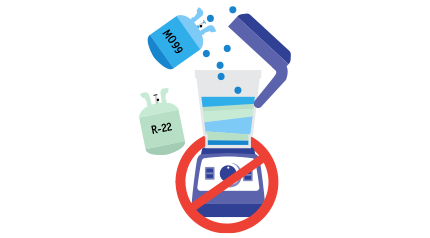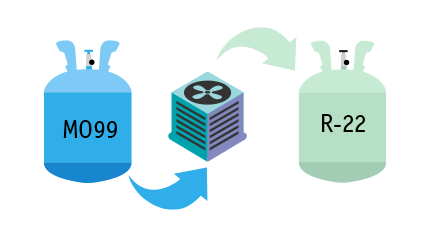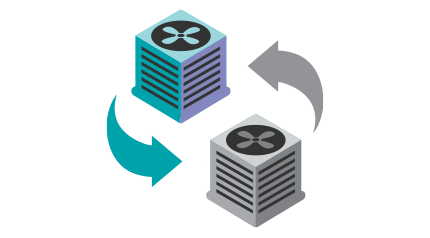Your Air Conditioner Repair Options: Recharge, Retrofit or Replace


If you have an air conditioner that was manufactured before 2013, you may have to answer this question eventually:
Should I recharge my system with R-22, have the system retrofitted to use an alternative refrigerant or replace it with a newer air conditioning unit?
There's no one-size-fits-all answer to this question, either. Each home (and homeowner) is unique, which is why you should understand the pros and cons of each option. Keep reading to learn more about your choices so that you can make the most informed and educated decision that works for your specific situation.
Recharging, or Topping Off, an Air Conditioner
When an air conditioner is low on refrigerant, the process of adding more is called "recharging" or "topping off." Essentially, the chemical refrigerant inside of the unit is being refilled.
While this is an acceptable practice during a repair or maintenance visit, it is becoming increasingly more expensive and time-consuming for several reasons:
- Due to the phasing out process, it can be difficult for even HVAC professionals to track down R-22 through suppliers.
- If a technician does work on R-22 systems, it can also take some time for them to acquire the refrigerant itself. That means you'll have to wait for your A/C to be functional again.
- Other technicians refuse to carry R-22 refrigerant anymore due to the detrimental environmental impact it has on the Earth's ozone.
If you choose to go with a more environmentally friendly option that provides a longer term fix, you are left with two more viable options: Retrofit or Replace.


The Benefits of Retrofitting Your Air Conditioner
Replacing an air conditioner is expensive, and your existing system may still have many years of viable use left. That's why retrofits have become so popular: In many cases, your best option to get your home cool again is to have your older system retrofitted to work with one of the many alternative refrigerants that are available today.
Read More [+]Most homeowners are unfamiliar with the ins-and-outs of having their air conditioning system retrofitted to use a new refrigerant. If an HVAC technician recommends a retrofit, they're making that recommendation with the following benefits in mind:
- R-22 is bad for the environment. Due to the chemical structure, it breaks down the Earth's life-protecting Ozone layer. Alternative refrigerants do not deplete the Earth's Ozone.
- HVAC technicians don't always carry R-22. R-22 refrigerant is becoming more difficult to acquire as the government continues to phase out its production, and most technicians won't have easy access to a supply.
- Retrofitting helps your air conditioner get repaired faster. R-22 refrigerant is expensive and hard to source, but alternative refrigerants are widely available. Using them will help get your home cooler, faster.
Retrofitting makes your A/C more serviceable in the future. Whether you have a Home Warranty Service Agreement, decide to discontinue your coverage or have never had a warranty, you know that home ownership is full of repairs. R-22 is becoming obsolete, and moving to an alternative refrigerant the next time you need air conditioner repairs will make future repairs easier, faster and better for the environment.
Why Does My Air Conditioner Need to be Retrofitted
You might be wondering, "Why does my air conditioner even need to be retrofitted for an alternative refrigerant? Can't I just mix the refrigerants?"
When moving from R-22 to an alternative refrigerant, the process is a bit more complicated than simply adding the new refrigerant into the existing system. That's because different refrigerants:
- Function under varying pressures.
- Require different oils (also called lubricants) to keep the compressor lubricated and functioning efficiently. For example, R-22 air conditioners use mineral oil, but R-410A systems require synthetic lubricants. Using the correct oil means your compressor will last longer without burning out.
Due to these differences in functionality, the air conditioner's existing R-22 refrigerant must be drained from the system properly. Additionally, certain seals and other components must be replaced.
Knowingly mixing refrigerants is also illegal. The EPA prohibits refrigerant mixing because mixed refrigerants cannot be recycled properly (and refrigerant chemicals cannot simply be released into the air — they must be removed from the system and recycled appropriately).
Thankfully, the retrofitting process is straightforward and can be completed quickly. If an HVAC professional suggests retrofitting your air conditioner for a new refrigerant, you can be confident that your A/C will be up and running in no time.


How an Older Air Conditioner Gets Retrofitted For Alternative Refrigerants
Retrofitting an older air conditioner to be compatible with an alternative refrigerant like MO99 ensures that your pre-2010 air conditioner can be more easily fixed in the future. There are many different types of alternative refrigerants available, but they all achieve the same goal: Getting your A/C to blow cold air.
Read More [+]Essentially, you're "future proofing" your home's air conditioning system when you opt to have it retrofitted. Future repairs will be easier and faster, and you'll regain functionality much faster than you would with a unit using R-22.
The retrofitting process is going to be different depending on the type of alternative refrigerant being used. For example, some alternative refrigerants are compatible with the type of oil that's used with your A/C's compressor, and others aren't. Retrofitting an R-22 system also requires replacement of certain parts in your air conditioner, such as the filter drier and critical elastomeric seals/gaskets.
Different refrigerants also have different pressures, and they can flow through the system in slightly different ways. All of these differences require specific tools and techniques, too.
Regardless of the alternative refrigerant being used, your air conditioner should be functional and cooling your home effectively after the process is complete. And, when refrigerant-based repairs are needed in the future, you'll be able to get those completed faster than you would with your old R-22 system.
Retrofitting an R-22 System for an Alternative Refrigerant: MO99
When an HVAC technician retrofits your air conditioner for an alternative refrigerant, the process is straightforward and can be completed quickly and efficiently.
These are the steps that will typically be completed:
Establish baseline performance.
First, the technician will check to see how the existing R-22 refrigerant is performing.Remove R-22.
Next, the R-22 refrigerant will be removed from the system. This process is also called recapturing — the refrigerant must be put into a recovery cylinder, and not released into the air where it can cause damage to the Earth's ozone. The amount removed will then be weighed.Replace components.
All retrofits require some equipment to be replaced. In this instance, the filter drier and critical elastomeric seals/gaskets will be replaced. The new equipment will be compatible with MO99.Evacuate the system and check for leaks.
The technician will then evacuate your air conditioner's system using a special vacuum pump. This process removes moisture and any other contaminants from the system.
Your A/C's compressor also needs oil to function — if necessary, that will be added during this step. No "oil change" is needed when switching to MO99.Charge with MO99.
"Charging" simply means adding the new refrigerant into your A/C's system.Starting and monitoring the system, and adjusting the thermal expansion valve (TXV).
It's time for a test run! The technician will fire up the air conditioner to ensure that everything is working properly.
The thermostatic expansion valve (TXV) is a critical piece of equipment that must also be checked during this step. This valve regulates the rate at which refrigerant flows into the air conditioner's evaporator coils. It will be adjusted as needed.Monitor the compressor's oil levels.
Your compressor needs oil to operate smoothly and efficiently, so the HVAC technician will double-check that the oil levels look good. If more oil is needed it will be added.Label the system.
Every air conditioner has a label that states the type of refrigerant and lubricant (oil) being used. Since a retrofit was just completed, the technician will change out your system's labels to reflect that information.


Replacing an Old Air Conditioner
There's a final option on your quest for a cool house: replacing your old air conditioner with a newer model.
Should you replace your air conditioner?
This is a personal question that only you can answer. Many times, retrofitting your air conditioning system is the fastest and best way to extend the system's lifespan.
Retrofitting an older system to work with alternative refrigerants extends the longevity of the air conditioner, lessens your environmental impact (manufacturing an entirely new A/C system is far more environmentally taxing than getting as much use as possible out of your existing system), and gives you back functionality of your air conditioning system quickly. In addition to the benefits of a retrofit, keep these things in mind when deciding whether to replace your air conditioner or repair with a retrofit:
Is having a new air conditioner important to you? For some homeowners, having modern systems in their home is important... and there's nothing wrong with that! If you want to replace your air conditioner with an upgraded model and you have the funds to do so, go ahead and purchase a new air conditioner.
If you do opt for a replacement, the best time to replace your air conditioner is during fall or spring. HVAC companies aren't as busy when the weather is more temperate, which means you can get installation scheduled faster. The best deals also tend to be available during these times, since temperatures are comfortable and homeowners aren't requesting service as often.
Newer models have the added bonus of using alternative refrigerants, too.
